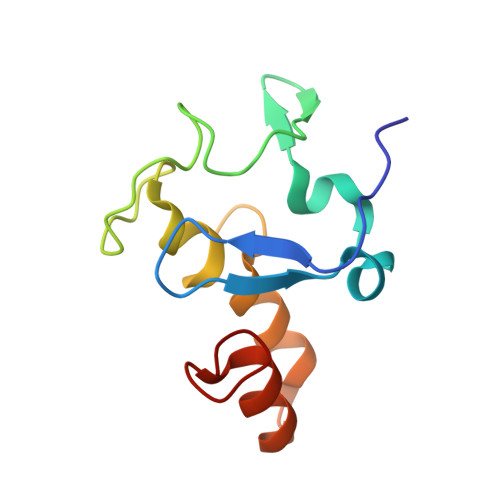Strategic roles of axial histidines in structure formation and redox regulation of tetraheme cytochrome c3.
Takayama, Y., Werbeck, N.D., Komori, H., Morita, K., Ozawa, K., Higuchi, Y., Akutsu, H.(2008) Biochemistry 47: 9405-9415
- PubMed: 18702516
- DOI: https://doi.org/10.1021/bi8005708
- Primary Citation of Related Structures:
2EWK, 2YXC - PubMed Abstract:
Tetraheme cytochrome c 3 (cyt c 3) exhibits extremely low reduction potentials and unique properties. Since axial ligands should be the most important factors for this protein, every axial histidine of Desulfovibrio vulgaris Miyazaki F cyt c 3 was replaced with methionine, one by one. On mutation at the fifth ligand, the relevant heme could not be linked to the polypeptide, revealing the essential role of the fifth histidine in heme linking. The fifth histidine is the key residue in the structure formation and redox regulation of a c-type cytochrome. A crystal structure has been obtained for only H25M cyt c 3. The overall structure was not affected by the mutation except for the sixth methionine coordination at heme 3. NMR spectra revealed that each mutated methionine is coordinated to the sixth site of the relevant heme in the reduced state, while ligand conversion takes place at hemes 1 and 4 during oxidation at pH 7. The replacement of the sixth ligand with methionine caused an increase in the reduction potential of the mutated heme of 222-244 mV. The midpoint potential of a triheme H52M cyt c 3 is higher than that of the wild type by approximately 50 mV, suggesting a contribution of the tetraheme architecture to the lowering of the reduction potentials. The hydrogen bonding of Thr24 with an axial ligand induces a decrease in reduction potential of approximately 50 mV. In conclusion, the bis-histidine coordination is strategically essential for the structure formation and the extremely low reduction potential of cyt c 3.
Organizational Affiliation:
Institute for Protein Research, Osaka University, 3-2 Yamadaoka, Suita, Osaka 565-0871, Japan.















